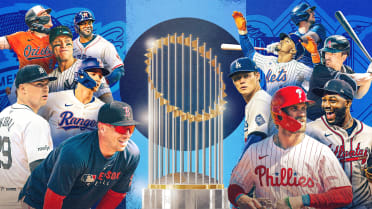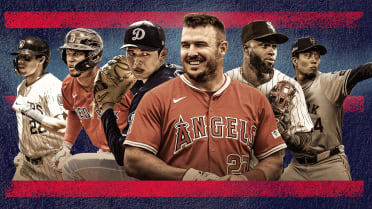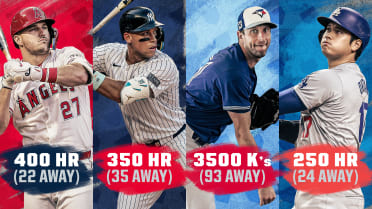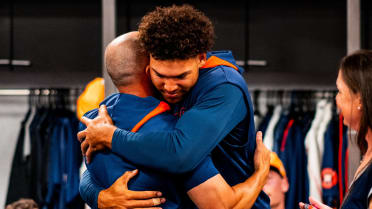On Aug. 2, 2019, we wrote an article here that suggested that Juan Soto was off to a historically notable start to his career -- even though at the time he was all of 20 years old and had been in the Majors for barely more than a year. Just based on what he'd done to that point, at an age where most players are in the low Minors or still playing in college, it seemed clear that it wasn't premature to start saying his name in the same context as some of baseball's best ever players.
When we wrote that, Soto's career line looked like this: .291/.403/.520 (OPS of .923)
Since then, over the final two months of 2019 and the shortened 2020 season, Soto has done this: .310/.445/.649 (OPS of 1.094).
That's ... considerably better. It gives him a career line to date of .295/.415/.557 (.972). If Soto was off to a start that rivaled Mickey Mantle before, where is he now? Looks like it's time to update that "best starts in history" list.
Let's set the criteria here. Soto turned 22 on Oct. 25, so he was 21 for the entirety of the 2020 season. He's taken 1,349 plate appearances. That's a bit of an awkward number, so let's look at hitters who had 1,000 plate appearances through their age-21 seasons. There are only 67 such players, so we're looking at a limited group here, but also, that's kind of the point. To even get 1,000 plate appearances before you turn 22 tells you a great deal about how talented you must be.
We'll sort these 67 players by OPS+, which attempts to adjust by ballpark and era -- important, given how many decades we're looking at -- and ... oh wow, that is certainly a list of names.
Best OPS+ through age 21, min. 1000 plate appearances
166 -- Mike Trout
161 -- Ted Williams
157 -- Jimmie Foxx
155 -- Rogers Hornsby
153 -- Ty Cobb
150 -- Soto <----
146 -- Mel Ott
145 -- Eddie Mathews
144 -- Mickey Mantle
139 -- Frank Robinson
Soto. Trout. Eight Hall of Famers.
Even that's underselling it, because there are Hall of Famers, and then there's Hall of Famers. There's not really an inner-circle throne room in Cooperstown, but if there were, these guys would all be in it, with Trout on his way.
So yes, Soto is off to an incredible start, and it feels like any numbers we offer to back that up pale in comparison to "being on a list with nine guaranteed Hall of Famers." But it feels like we ought to anyway, just because what he's done thus far has been that impressive. Let's check him out in a variety of important offensive stats covering 2018-20.
There is, of course, more. In 2020, Soto hit .447 with a .921 slugging on breaking balls. Pitch-tracking data goes all the way back to 2008, and in that time, no one (of the thousands of times when a hitter has seen at least 200 breaking balls in a season) has had a more successful year against breakers. That's convenient, really, given that fastballs are quickly falling out of style in favor of ... more breaking pitches.
Over at FanGraphs, Dan Szymborski rolled out his 2021 ZiPS projections for the Nationals, which annually comes with a matching historical player comp for each current player. Soto's historical comparable? Ted Williams. "Not the Ted Williams who played in the Minors for the Mariners, not a data error that led to an odd result, but the Ted Williams," wrote Szymborski. "I believe this is a first."
Imagine hearing a 22-year-old hitter being compared to arguably the greatest pure hitter of all time and thinking to yourself well, yes. That tracks.
We could go on like this, endlessly. This year, he had the fourth-best rate of turning swings into hard-hit balls, which tells you a lot about his swing decisions. He was simply the best hitter in the game this year, ahead of Freddie Freeman, by a Statcast metric that combines amount of contact (strikeouts and walks) with quality of contact (exit velocity and launch angle.) He's the best hitter in franchise history, and we're including the Montreal years. He is, again, only a few weeks into his 22nd year.
But we thought we'd approach this in a different way, too. When we looked at the 67 players to get at least 1,000 plate appearances through age 21, we noticed some all-time greats at the top, but also down the list there were some players who got off to relatively poor starts (Alan Trammell, 84 OPS+, Robin Yount, 86 OPS+) and still ended up with great careers. While Soto is obviously in a different stratosphere, as we said above, simply getting this many plate appearances this young says a lot.
So forget production for a minute; what kind of career do guys like this end up with? If we're already calling Soto -- who is less than a year older than the No. 1 pick in the most recent Draft, Spencer Torkelson -- a sure-shot Hall of Famer, we might as well back it up.
Well, there's 67 players. Let's break them out.
Hall of Famers (25)
Ivan Rodriguez, Ken Griffey Jr., Roberto Alomar, Rickey Henderson, Alan Trammell, Robin Yount, Johnny Bench, Ron Santo, Orlando Cepeda, Bill Mazeroski, Frank Robinson, Al Kaline, Roberto Clemente, Hank Aaron, Eddie Mathews, Mickey Mantle, Ted Williams, Bobby Doerr, Arky Vaughan, Mel Ott, Jimmie Foxx, Freddie Lindstrom, Travis Jackson, Rogers Hornsby, Ty Cobb
Twenty-five! And not even of 67, remember, because as you'll see in a minute, there's 13 names who aren't yet eligible for the ballot. So that's 25 of 53, which is a 47.2% induction rate. Let's not gloss over that fact: If you're good enough to get 1,000 plate appearances before 22, regardless of how good you were in those plate appearances, there's a nearly 50/50 shot that you're going to Cooperstown.
Soto, obviously, did more just than just accumulate those place appearances. He excelled in them.
Pending/Upcoming Hall of Fame cases (4)
Andruw Jones, Gary Sheffield, Adrián Beltré, Alex Rodriguez
Jones and Sheffield are currently on the ballot, and each have pretty compelling cases, though both seem somewhat unlikely to actually make the cut. No matter; that they're even in that conversation tells you a lot about how great their careers were. When Beltré becomes eligible, he seems incredibly likely to gain induction. A-Rod would be a first-ballot no-brainer on merit alone, though all of the off-field baggage he brings may complicate this case enough to keep him out.
Still active (11)
Juan Soto, Mike Trout, Miguel Cabrera, Bryce Harper, Carlos Correa, Manny Machado, Ronald Acuña Jr., Jason Heyward, Starlin Castro, Elvis Andrus, Justin Upton
Let's stipulate that there's a pair of absolute, no-doubt-about-it slam-dunk Hall of Famers here in Trout and Cabrera. Acuña is less than a year older than Soto and is similar in many ways; this article could easily be about him in the same way, as he's also on a Cooperstown track. Machado and Harper are going to have their own Hall of Fame cases when their careers are over; Correa is a step below, but he might be there someday, too.
The remaining four -- Upton, Andrus, Castro and Heyward -- won't be in Cooperstown conversations, but they've made 11 combined All-Star Games, and each has had good-to-at-times-great careers. There's no flops here.
All-Stars (16)
Edgar Renteria, Ruben Sierra, Butch Wynegar, Claudell Washington, Buddy Bell, Cesar Cedeno, Rusty Staub, Boog Powell, Vada Pinson, Eddie Yost, Cass Michaels, Frankie Gustine, Buddy Lewis, Phil Cavarretta, Cecil Travis, Ed Kranepool
This is an interesting and varied group, with a few MVP seasons (Cavarretta won the NL in 1945, and Powell won the AL in 1970), along with a handful of names you probably don't recognize. Still, to even get to one All-Star Game is a place most players don't get to.
Interestingly, when we first thought about this group, we thought several of them would only be All-Stars in their "through age-21" seasons and then not at all after. As it turned out, that only occurred once, with Kranepool, who ended up playing 18 seasons with his hometown Mets.
Solid good (5)
Rick Manning, Bob Bailey, Stuffy McInnis, Dick Hoblitzell, Sherry Magee
No need to spend too much time here, other than to say these guys had solidly decent careers. Manning, for example, played parts of 13 seasons in the outfield for Cleveland and Milwaukee. Bailey had the first hit in Expos history, and he was teammates with 15 Hall of Famers in his 17-year career -- greats like Roberto Clemente, Joe Morgan, Tom Seaver and Don Drysdale. The other three all debuted in the early part of the 20th century.
Tragedy (2)
Ken Hubbs, Tony Conigliaro
Unfortunately, not everyone had the chance to show what they could do over a long career. Hubbs, the 1962 NL Rookie of the Year, perished in a small plane crash in Utah in 1964. Conigliaro's career was permanently impacted by a beaning in 1967, and his playing days were all but done by age 26.
Didn't amount to much (4)
Sibby Sisti, Bob Kennedy, Whitey Witt, John Knight
Fine, they can't all be winners. We'll note, however, that each of these four made their debut before World War II. It's been a long time since a player who got this much playing time this young didn't pan out.
And that, really, is the point. We're obviously being a little facetious when we say that Soto (and Acuña, for that matter) is basically already a Hall of Famer. He's entering his age-22 season, after all. He won't even be eligible for the conversation until after the 2027 season, when he'd have his 10th season in the books. But based on the way he's started and the way he's improved, you are absolutely witnessing the start of an all-time great career barring some unthinkable tragedy. No one has ever started this well and not found themselves in Cooperstown.
Soto homered on the first pitch of the first start of his career, back in 2018. It's not hard to think we'll look back on that some day as the first great moment of one of baseball's greatest careers.
Mike Petriello is a stats analyst for MLB.com, focusing on Statcast and Baseball Savant, and is also a contributor to MLB Network.




